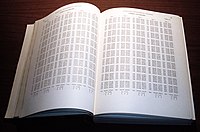Abramowitz and Stegun
 Page 97 showing part of a table of common logarithms. | |
| Author | Milton Abramowitz and Irene Stegun |
|---|---|
| Language | English |
| Genre | Math |
| Publisher | Dover Publications |
Publication date | 1964 |
| Publication place | USA |
| ISBN | 0-486-61272-4 |
| OCLC | 18003605 |
Abramowitz and Stegun is the informal name of a mathematical reference work edited by Milton Abramowitz and Irene Stegun of the U.S. National Bureau of Standards (now the National Institute of Standards and Technology). Its full title is Handbook of Mathematical Functions with Formulas, Graphs, and Mathematical Tables.
Since it was first published in 1964, the 1046 page Handbook has been one of the most comprehensive sources of information on special functions, containing definitions, identities, approximations, plots, and tables of values of numerous functions used in virtually all fields of applied mathematics.[1] The notation used in the Handbook is the de facto standard for much of applied mathematics today.
At the time of its publication, the Handbook was an essential resource for practitioners. Nowadays, computer algebra systems have replaced the function tables, but the Handbook remains an important reference source. The foreword discusses a meeting in 1954 in which it was agreed that "the advent of high-speed computing equipment changed the task of table making but definitely did not remove the need for tables".
More than 1,000 pages long, the Handbook of Mathematical Functions was first published in 1964 and reprinted many times, with yet another reprint in 1999. Its influence on science and engineering is evidenced by its popularity. In fact, when New Scientist magazine recently asked some of the world’s leading scientists what single book they would want if stranded on a desert island, one distinguished British physicist[2] said he would take the Handbook. The Handbook is likely the most widely distributed and most cited NIST technical publication of all time. Government sales exceed 150,000 copies, and an estimated three times as many have been reprinted and sold by commercial publishers since 1965. During the mid-1990s, the book was cited every 1.5 hours of each working day. And its influence will persist as it is currently being updated in digital format by NIST.
Editions
Because the Handbook is the work of U.S. federal government employees acting in their official capacity, it is not protected by copyright. While it can be ordered from the Government Printing Office, it has also been reprinted by commercial publishers, most notably Dover Publications (ISBN 0-486-61272-4), and can be legally viewed and downloaded off the web.
Successor
A digital successor to the Handbook, long under development at NIST, was released as the “Digital Library of Mathematical Functions” (DLMF) on May 11, 2010, along with a printed version, the NIST Handbook of Mathematical Functions, published by Cambridge University Press (ISBN 978-0-521-19225-5). More information can be found at NIST.
See also
- Numerical analysis
- Philip J. Davis, author of the Gamma function section and other sections of the book
- Digital Library of Mathematical Functions (DLMF), from the National Institute of Standards and Technology (NIST), is intended to be a replacement for Abramowitz and Stegun's Handbook of Mathematical Functions
- Boole's rule, a mathematical rule of integration sometimes known as Bode's rule, due to a typo in Abramowitz and Stegun (1972, p. 886) that was subsequently propagated [4]
Notes
- ^ Boisvert, R. et al. (2011) A Special Functions Handbook for the Digital Age, NAMS 58(7), 905-911.
- ^ Michael Berry, New Scientist 22 November 1997
- ^ NIST at 100: Foundations for Progress, 1964:Mathematics Handbook Becomes Best Seller — http://www.100.nist.gov/ph_spaceage.htm
- ^ "Boole's Rule - from Wolfram MathWorld". Mathworld.wolfram.com. 2009-10-27. Retrieved 2009-11-13.
References
- Abramowitz, Milton; Stegun, Irene A., eds. (1972), Handbook of Mathematical Functions with Formulas, Graphs, and Mathematical Tables, New York: Dover Publications, ISBN 978-0-486-61272-0
- Boisvert, R. F.; Lozier, D. W. (2001), "Handbook of Mathematical Functions", in Lide, D. R. (ed.), A Century of Excellence in Measurements Standards and Technology (PDF), CRC Press, pp. 135–139, ISBN 0-8493-1247-7 A history of the activities leading up to and surrounding the development of the Handbook
External links
- How to order the book from GPO.
- A high quality scan of the book, in PDF and TIFF formats, hosted at the University of Birmingham, UK
- The book in scanned format, hosted at Simon Fraser University.
- Another scanned version by ConvertIt.com
- Empanel version
- NIST Digital Library of Mathematical Functions, the digital companion to the Handbook
